In this unit we will see everything in respect to the millah, the planted field, namely what is planted and seasons for Indigenous communities from Chicontepec, Veracruz.
Note: Images in this lesson were created by the following people:
CC BY Sabina and Catalina Cruz
CC BY Josefrayn
Quemman motocah cintli pan ce xihuitl (When corn is planted during all the year)
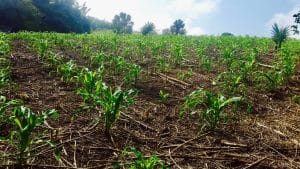
During the year, things are planted twice per year: once during the hot season, and other during the rainy season.
/Tonalmilli/ “December — April”
Tonalmilli is the name because it occurs during the hot season. Once December ends, there is little rain and the corn crops grows. During this stage, time and care must be given to the crops. First because there is a lot heat, and second because when the crops grow, worms and maggots appear and try to eat the corn stem. For this reason, communities spent time and energy so that corn grows for the month of April.
/Xopamilli/ “June — September”
Xopamilli is the name because it is the rainy season. Generally, the month of June is when the rains come in the region. Corn is planted during the first rain because it is when the land is soft. At the same time, communities ask for little rain because it is possible for the crops to drown. Not only do people need to care for their crops due to rain, they must also contend with worms and maggots. The crops are ready by September.
Quen moquixtia xinachtli (When the corn is taken out)
Achtohui quen moquixtia xinachtli
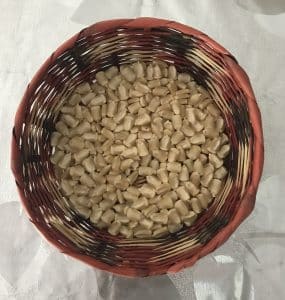
Oncah ome tlamantli pilcintzin: pilpetlayoh huan pilmolcatzin. Quemman moquixtia pilxinachtzin, achtohui mocui pilcintzin tlen petlayoh huan huehhueyi teipan moxipehua. Quemman tlaxipehualia pilcintzin mooya zan tlen tlatlahco tlen olotl, zan tlen tlancochhuehueyi huan tlen iyahyacapan mocahua pan olotl ni axcanah quitequihuiah pampa pilcuecuetztzitzin huan axcanah eli. Yeca quitlapehpeniah pilcintzin zan tlen yehyectzitzin. Ni pilxinachtzin mocahua pan chiquihuitl pampa teipan moaquechiz. Quemman quiquixtiah pilxinachtzin axcanah mocalaquia ce conetl pampa ya monenequi, ni monequi quiquixtiz tetah zo tenan, pampa ya axcanah monenequi, ya quimati tlen quichihuaz huan queniuhqui. Iuhcatzan ticmatih ni tlamantli quichihua maz zan tlacatl pampa ce cihuatl motequihuia ica ceyoc tlamantli calihtic.
Moaquechia pilcintzin (pilxinachtzin)
Quemman moaquechiz pilxinachtzin macehualli monequi quizancehcotiliz ce cobetah ica tlahco pilatzin. Ni tlamantli tlaaquechiliztli mochihua ica tiotlac pampa pilxinachtzin monequi mocahuaz pan pilatzin ceyohual. Cequin quitlaliah tlaixpantenno zo canahya campa axacah quiolinizceh. Quemman quipixtocca nochi tlamantli tlen quitequihuiz quitema nopa pilcintzin pan pilatzin, tlacatl momahhuia pampa quinequi ma teyotia/ ma miaquiya ipilcin, queuhquinon quicahua pan pilatzin.
Moquixtia pilxinachtzin
Ica cualcan tlacatl quiquixtia pilxinachtzin pan ce pilchiquitzin huan quicahua ma ayotemo, noque ayotemo pilxinachtizn, ya monemilia ica cequinon tlamantli tlen quitlalia pan tlaixpan huan pan xicnahtli, quitlalia xochimantli, quitlatia ce pilcantelahtzin, quicui tlicolli pan popochcomitl huan quitemilia copalli tlen ica quipopochhuizceh pilcintzin. Cihuatl ya mocafenmana, pampa nouhquiya quimana ome tazah cafen tlaixpan zo campa eltoc pilxinachtzin. Nouhquiya quicoa pilpantzin. Nochi nopa tlamantli tlen quicentiliah pan calli motlalia tlaixpan huan tlacatl pehua momaihtoa ce quetzin. Motlazcamatilia ica totiotztzin pampa quinequi ma quipalehuican apachaneh ma zancualli quiahatequican pilcintzin.
Cehcen tocaitl tlen etl huan ipohual (Each name of bean and their seasons)
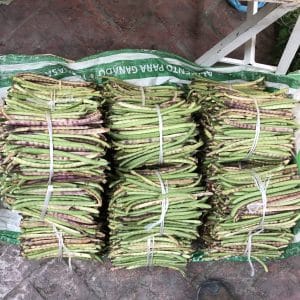
In Chicontepec, we have one color of bean but with different names: “chichimequetl,” “san miguel,” “huehuentzin,” “tonaletl,” “emecatl” and “neletl,”each of these with different seasons. Additionally, each of these beans has their unique way of preparation.
/Chichimequetl/ it is known as the bean of the dog. Its vine is “tlapalli” or reddish, and its seeds are round. These beans are ready for Day of the Dead in the month of November. The food that is made from these beans is called, “patzcalli” which includes sesame seeds.
/Frijol San Miguel/ these beans have the name of San Miguel because they are ready in September and the September 30th is the same day of the feast of San Miguel. This bean is planted during the month of June.
/Huehuentzin/ these beans are known as the old beans and their vines are thick.
/Tonaletl, tonalmilli/ this bean is known as the bean of the sun, and they are planted during the month of January so that they are ready for June. The bean is also planted in March so that they are ready in June. This bean is planted next to the stems of corn, because the vines of the bean crawl up the corn stems. These beans must cared for because if there is no rain, the sprout will delay.
/Emecatl/ this bean is ready in November, which is why it is planted during the month of June. This bean is prepared with sesame seeds so that it can be offered during the Day of the Dead.
/Neletl/ this bean is known as the bean of the month of May. It is planted twice every year. Once in the month of September so they are ready in the month of January. But they are also planted during the month of January so that they are ready for April. These beans are made into stews.
Cequin tocayotl tlen tlacatl itequiuh pan milli (Some names of male jobs in the planted field)
In the communities of Chicontepec the crops are typically worked by male members of society. They leave their houses early in the day in order to work all day. After a long day, they return to their homes in the evening. There are many activities in the planted fields, and sometimes people help each other. In some occasions, when people help each other, they are compensated with monetary payment or they will trade labor. In other words, one person will work the planted field for another, in exchange for labor at their planted field.
Nican tiquittah ce tlacatl toca, quitoca cintli
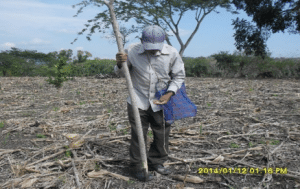
Itztoc ce tlacatl cuaquixtia
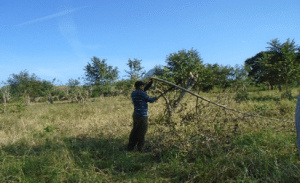
Itztoc ce tlacatl cuahuehhueloa
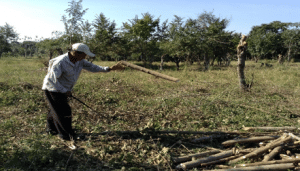
Tlacatl cuatecpichoa
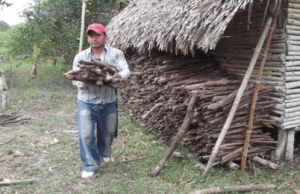
Tlacatl tlahchinoa
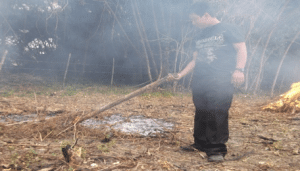
Tequitl ce (Activity One):
Xitlananquilican ne tlahtolpamitl tlen quemman motocah cintli (Respond to this sentence about when corn is planted)
Xiquihcuilo ica náhuatl; quemman quitocah cintli campa ta tihuallauh huan queniuhqui itocah.
Tequtil ome (Activity Two): Xitlananquilican ne tlahtlaniliztli tlen etl (Answer these questions about beans)
¿Quezqui tlamantli etl tiquixmati?
¿Quemman motoca etl tlen tiquixmati?
¿Queniuhqui mochihchihua etl tlen ta tiquixmati?
Tequitl eyi (Activity Three): Xitlananquilican ne tlahtlaniliztli (Answer this question)
¿Tlen tlamantli tequitl hueli ticchihua ta?

